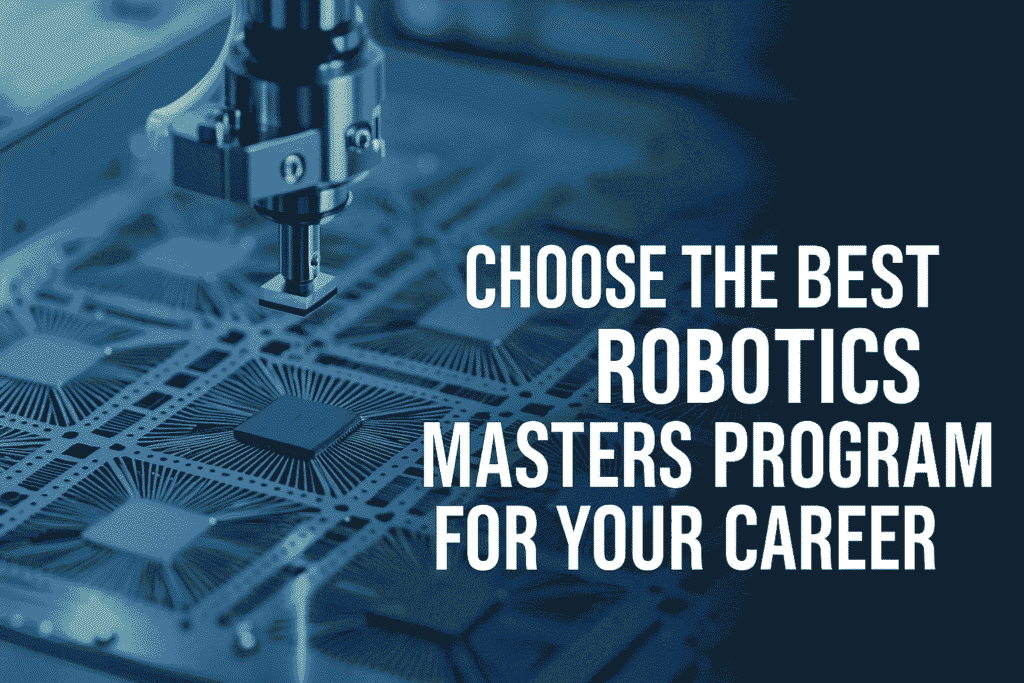Some fields evolve. Robotics? It reinvents.
From autonomous delivery systems to AI-guided surgery, robotics is reshaping industries at a pace few others can match. And if you’re aiming to be part of this shift, a master’s degree in robotics can set the tone for your entire career.
But here’s the challenge: there’s no one-size-fits-all solution. The “best” program depends on your goals, your interests, and how you want to grow. This post isn’t about rankings or brand names. It’s about helping you choose smartly, based on what matters.
Let’s break it down.
Start With Where You’re Headed
Before anything else, ask yourself one thing: what kind of work do you see yourself doing in robotics?
Do you want to design machines? Build smart software? Dive into human-robot collaboration? Or focus on sensors and systems? These aren’t the same path, and good programs often specialize.
If you’re unclear, that’s okay. But it helps to know if your interest leans toward:
- Mechanical engineering and hardware
- Control systems and embedded design
- AI, machine learning, or vision systems
- Bio-inspired or assistive robotics
- Research, industry, or entrepreneurship
Understand What You’ll Study
Here’s where most people rush. A fancy brochure or university name might feel reassuring, but the course list tells the real story. A solid robotics curriculum will cover:
- Robot kinematics and dynamics
- Motion planning and control theory
- Microcontrollers and embedded systems
- Computer vision and object tracking
- AI integration and path optimization
Now, not every course will use the same names. But you’re looking for coverage across software, hardware, systems integration, and problem-solving. If a program leans too much toward theory with no applied learning, take a pause.
Some of the best robotics masters programs include long-term projects, lab modules, or cross-disciplinary tracks. Those are gold. They help you build, debug, and apply, not just memorize.
Who’s Teaching You Matters More Than You Think
A good lab? Great. A good professor? Career-changing.
Faculty make or break the experience. Not just in lectures, but in mentoring, project feedback, and the networks they open up. When reviewing programs, look them up. A few signs that you’re looking at a strong team:
- Professors with published research in robotics journals
- Ongoing industry collaborations or funded projects
- Involvement in competitions or standards development
- Diverse expertise across software and mechanical systems
And don’t stop at titles. If you can, read a paper or check a recent project by the faculty. If their work excites you, you’re in the right zone.
Labs, Tools, and Space to Experiment
In robotics, you need room to tinker. If a program looks great on paper but gives you no access to prototyping labs or test rigs, that’s a red flag. Look for:
- Fabrication labs with 3D printing and machining tools
- Sensor kits, microcontrollers, robot arms, mobile platforms
- Simulation environments (Gazebo, V-REP, MATLAB)
- Dedicated spaces where students build and test regularly
Outcomes Over Optics
Rankings? They’re just the surface. What matters is this: what do graduates go on to do? Where do they work? What kinds of problems do they solve? Check the alumni section. Look on LinkedIn. Browse a few profiles. Find out:
- Are they working in core robotics roles?
- Are they leading teams, building products, or doing real research?
- Have you launched companies, joined R&D labs, or moved into policy or design strategy?
The best robotics masters programs help their students make an impact, not just pass exams.
Internships, Projects, and Industry Ties
You can’t learn robotics without applying it. Programs that embed real projects, internships, or industry challenges into the curriculum stand out. Here’s what to look for:
- Semester-long industry projects (with deliverables and reviews)
- Capstone projects in collaboration with companies or labs
- Internship tie-ups through the university’s network
- Faculty-guided partnerships with actual problem statements
Support Systems You Can Rely On
Choosing a program isn’t just about labs and lectures. It’s also about whether the environment supports you when things get hard, and they will. Explore the following-
- Career services and mentoring
- Soft skills workshops (CVs, interviews, negotiations)
- Access to mental health or stress support
- Alumni networks and knowledge-sharing circles
It’s easy to ignore these when looking at brochures. But when deadlines stack and projects stretch, having strong support makes a real difference.
Duration, Format, and Cost
Most master’s programs in robotics run 1.5 to 2 years. Some are fast-tracked; others involve dual degrees or research extensions. Ask yourself:
- Do you want a quick industry entry or time to explore deeply?
- Is the tuition worth the likely salary gain?
- Does the school offer scholarships, assistantships, or work-study support?
Final Thoughts
Robotics is not a field for bystanders. It rewards those who experiment, commit, and adapt fast. The master’s program you choose should reflect that. So take time. Review course lists. Read faculty profiles. Email alumni. The best robotics masters programs don’t just prepare you for today. They prepare you for the questions nobody’s asked yet. And if you pick the one that challenges you just enough to grow, you won’t just be building machines. You’ll be building your future.
- How to Choose the Best Robotics Masters Program for Your Career?
- The best robotics masters programs don’t just prepare you for today. They prepare you for the questions nobody’s asked yet.
- Digital Transformation, Smart Manufacturing, Industry 4.0
Related posts:
 High-Quality Biomedical Waste Incinerators & Laboratory Glassware Made in India
High-Quality Biomedical Waste Incinerators & Laboratory Glassware Made in India
 Understanding the Role of IoT in Modern Manufacturing: A Comprehensive Guide to Smart Factories and Industrial Transformation
Understanding the Role of IoT in Modern Manufacturing: A Comprehensive Guide to Smart Factories and Industrial Transformation
 Smarter Business Networks Start with a Cisco Solution Provider Partner
Smarter Business Networks Start with a Cisco Solution Provider Partner
 Best Account Management Software for All Businesses – EmizenTech
Best Account Management Software for All Businesses – EmizenTech
 Top 15 Global Website Design Companies You Can Hire in the 2025
Top 15 Global Website Design Companies You Can Hire in the 2025
 Empowering Qatari Retail Businesses with Microsoft Dynamics 365 Commerce
Empowering Qatari Retail Businesses with Microsoft Dynamics 365 Commerce
 Top On-Demand Dating App Trends to Watch and Leverage in 2025
Top On-Demand Dating App Trends to Watch and Leverage in 2025
 Safety Procedures in Heavy Equipment Moving: Best Practices for Workplace Security
Safety Procedures in Heavy Equipment Moving: Best Practices for Workplace Security







